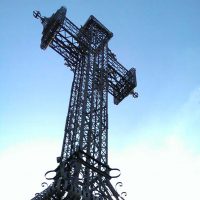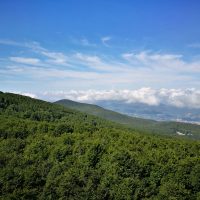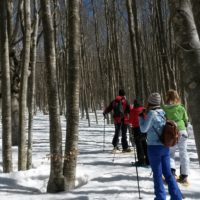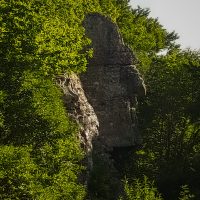Mount Amiata in Tuscany, with its 1738 meters of height, overlooks the Val d’Orcia and the Maremma and separates the province of Siena from that of Grosseto. The mountain is covered with vegetation up to its peak. It offers tourists and its inhabitants very suggestive views and landscapes. It is a ski resort with its 12 slopes and 8 ski lifts during the winter. While in the summer it is the destination of many tourists who are passionate about fresh air and take refuge in the woods to escape the heat of the town, collect mushrooms, go trekking, go horse riding and much more.
Must-see places on Mount Amiata

The Amiata peak
The Amiata peak can be easily reached by car, motorbike, or bus from almost all the Amiata towns. You can leave your vehicle in the large car park 500 meters from the top and reach the peak on foot or by cable car. On the peak there is a 22-meter-high metal Cross, commissioned by Pope Leone XIII, a historical and Christian symbol of the people of Amiata.
The Cross was built in the early 1900s, destroyed in the Second World War, and rebuilt in 1946. It attracts thousands of tourists every year. The Cross is not the only attraction at the peak. In fact, at its feet you will find one of the most visited observation points of Amiata. From there you can see a panorama that will leave you speechless. At about 200 meters and always at the same altitude, there is the Madonna degli Scout, a marble statue erected over the lava rocks which are still very visible today.
To the peak there are also excellent restaurants and hotels ready to provide you with the best typical dishes of the area. In winter you can find a small ski lift for beginners and ski rental. There are also some webcams on the peak that are not currently available on this site.

Mountain huts
Like in all self-respecting mountains, Alpine, Apennine or as in the case of Mount Amiata “anti-Apennines”, there are find mountain huts. They are places that in less recent times were designed to offer refreshment to travellers who arrived from the valley.
The Amiata has three main mountain huts, the “Terzo Rifugio” at the foot of the peak, the “Secondo Rifugio” also called the Cantore refuge, the “Primo Rifugio”, about 7km from the village of Abbadia San Salvatore. The third hut practically coincides with the peak, it is only a few hundred meters from it and it is very close to the car park.
At the third hut you will find some hotels and bars where you can stop off. Even at the second hut you can find refreshment but also find the departure of two of the ski lifts, one of which is also open in the summer. The first hut, once a ski slope now disused, offers a beautiful picnic area. All the huts are characterized by the presence of vast grassy lawns. Ski equipment rental services are also available at the second Amiata hut in winter.

The meadows of Mount Amiata
Amiata is not only rich in forest vegetation. Along the road that goes from Castel del Piano to the peak (but you can also get there from Arcidosso, Piancastagnaio and Abbadia San Salvatore), you come across two of the most well-known meadows on the mountain.
The first meadow you meet is the Prato delle Macinaie located in the municipality of Castel del Piano, about 1500 meters above sea level. At the edge of the lawn you will find the Adventure Park, a path suspended between trees, suitable for adults and children, excellent hotels, and bars. You should go there for a picnic day in summer, and in winter if you are looking for a departure station for the ski lifts.
Proceeding towards the peak we meet the Prato della Contessa, slightly smaller in size, at a slightly higher altitude. This one too, like the other one, has a grassy mantle on which to rest in the shade of centuries-old beech trees.
We should also mention the Prato della Marsigliana, very close to the Cantore hut, ending in winter with one of the many ski slopes on Amiata.

Observation points
Observing the panorama is certainly one of the activities we all do when we get on the Amiata. Surely the most visited observation point is at the foot of the Cross. From there the eye can clearly see Lake Bolsena and the whole Val di Paglia. The Val’Orcia is instead visible from the top of the mountain at the beginning of the ski slope of the peak.
We can find an observation point along the road that leads from the La Contessa alla Vetta meadow. It is referred to as the Observation Point of the Valle dell’Inferno, on clear days you can clearly see the sea, the Mount Argentario, the island of Giglio and Elba.
However, there are so many observation points along the paths of the Amiata, you just have to walk on the paths and on the ski slopes to come across breathtaking views. An editorial advice. Go up on the ski lift that from the summit leads to the Cantore hut, going down you will have 10 minutes to enjoy the Val d’Orcia until you see Siena, on clear days.

Snow in winter, trekking and mushrooms in the summer
We should also mention the spring and autumn seasons. In these periods, in fact, the colours of the woods are extremely fascinating.
Amiata is known, and was even more so in the past, as a winter resort and in the summer as a destination for enjoying a little fresh air, for trekking and long walks.
Do not underestimate the tourism related to mushroom picking, which, in certain months of the year, attract thousands of people in search of the famous Amiata mushrooms. But… Look out! Mushroom picking is regulated, so check with the towns where you collect the forest products.

Don’t miss Dante’s stone
A few kilometres from Abbadia San Salvatore, after leaving the ruins of the mine, you will see a completely natural reproduction of the profile of the famous poet. A giant stone overlooking the road, which looks out from the trees. An extraordinary resemblance that for many years has named this rock, the stone of Dante.
In the gallery you can find the enlarged photo and on the map the road to reach it.
Fire only in equipped areas
Every year thousands of people come to the woods of the Amiata to enjoy a BBQ with friends. There are many areas equipped to make fires with wooden tables and benches to sit on. Do not light fires in the woods by improvising hearths that can escape your control. The Amiata is too good to go up in flames.
How to get to Monte Amiata
There are many roads that go from the villages down to the peak. From Abbadia San Salvatore, Piancastagnaio, Santa Fiora, Arcidosso, Castel del Piano and Seggiano you will find directions to reach the peak of the mountain. To travel by car but also suitable for those with a passion for two wheels.








